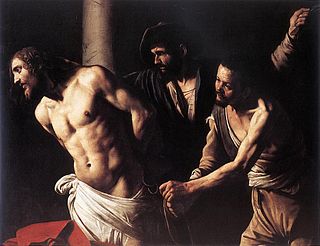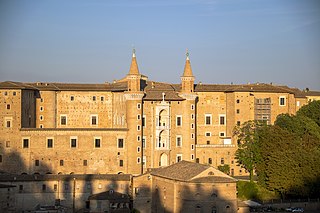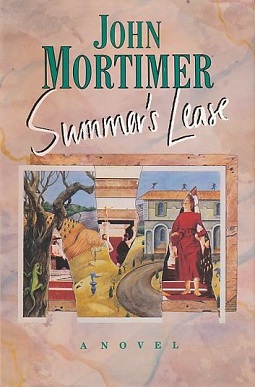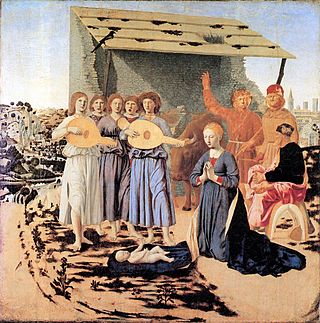
Piero della Francesca was an Italian painter of the Early Renaissance. To contemporaries he was also known as a mathematician and geometer. Nowadays Piero della Francesca is chiefly appreciated for his art. His painting is characterized by its serene humanism, its use of geometric forms and perspective. His most famous work is the cycle of frescoes The History of the True Cross in the church of San Francesco in the Tuscan town of Arezzo.

The Taking of Christ is a painting, of the arrest of Jesus, by the Italian Baroque master Michelangelo Merisi da Caravaggio. Originally commissioned by the Roman nobleman Ciriaco Mattei in 1602, it is housed in the National Gallery of Ireland, Dublin.

Ecce Homo is a painting by the Italian Baroque master Caravaggio. It is housed in the Palazzo Bianco, Genoa. Contemporary accounts claim the piece was part of a unannounced competition between three artists, and that the Caravaggio version was eventually sent to Spain.

Christ at the Column, is a painting by the Italian Baroque painter Caravaggio, now in the Musée des Beaux-Arts de Rouen, Rouen, France.

The Flagellation of Christ is a painting by the Italian Baroque painter Caravaggio, now in the Museo Nazionale di Capodimonte, Naples. It is dated to 1607, and may have been reworked by the artist in 1610. It is not to be confused with Christ at the Column, another Flagellation by Caravaggio of the same period.

Giovanni Battista Caracciolo (1578–1635) was an Italian artist and important Neapolitan follower of Caravaggio. He was a member of the murderous Cabal of Naples, with Belisario Corenzio and Giambattista Caracciolo, who were rumoured to have poisoned and disappeared their competition for painting contracts.

The Ducal Palace is a Renaissance building in the Italian city of Urbino in the Marche. One of the most important monuments in Italy, it is listed as UNESCO World Heritage Site since 1998.

Madonna in Glory with Seraphim is a painting by the Italian Renaissance painter Sandro Botticelli, executed c. 1469–1470. It is housed in Galleria degli Uffizi.
The Baptism of Christ is an event described in the gospels of Matthew, Mark and Luke.

Summer's Lease is a novel by Sir John Mortimer, author of the Rumpole novels, which is set predominantly in Italy. It was first published in 1988 and made into a British television mini-series, first shown in 1989. The title "Summer's Lease" is a play on a line from William Shakespeare's Sonnet 18: And summer's lease hath all too short a date. The novel involves the leasing of a Tuscan villa for the summer holidays. It is divided into six parts: "Preparations", "Arrival", "First Week", "Second Week", "Third Week", and "The Return".

Roberto Longhi was an Italian academic, art historian, and curator. The main subjects of his studies were the painters Caravaggio and Piero della Francesca.

This article about the development of themes in Italian Renaissance painting is an extension to the article Italian Renaissance painting, for which it provides additional pictures with commentary. The works encompassed are from Giotto in the early 14th century to Michelangelo's Last Judgement of the 1530s.

The image of La Madonna del Parto is a religious depiction of the Blessed Virgin Mary as pregnant which was popularised in Tuscany, Italy during the 14th—century.

The Baptism of Christ is a painting by the Italian Renaissance master Piero della Francesca. Painted in egg tempera on two panels of poplar wood, the dating is controversial – some give it a very early date, perhaps 1439; others much later, around 1460. It is held by the National Gallery, London.

The Resurrection is a fresco painting by the Italian Renaissance master Piero della Francesca, painted in the 1460s in the Palazzo della Residenza in the town of Sansepolcro, Tuscany, Italy.

The Flagellation of Christ, in art sometimes known as Christ at the Column or the Scourging at the Pillar, is an episode from the Passion of Jesus as presented in the Gospels. As such, it is frequently shown in Christian art, in cycles of the Passion or the larger subject of the Life of Christ. Catholic tradition places the Flagellation at the beginning of Via Dolorosa in Jerusalem, and the modern alternate Stations of the Cross locate it at the fourth station; it represents a Sorrowful Mystery of the Rosary. The column to which Christ is normally shown to be tied, and the rope, scourge, whip or birch are elements in the Arma Christi. The Basilica di Santa Prassede in Rome is one of the churches claiming to possess the original column or parts of it.

The Flagellation of Christ is a painting by Piero della Francesca in the Galleria Nazionale delle Marche in Urbino, Italy. Called by one writer an "enigmatic little painting," the composition is complex and unusual, and its iconography has been the subject of widely differing theories. Kenneth Clark called The Flagellation "the greatest small painting in the world".

The Flagellation Standard was a double-sided tempera on panel painting by Luca Signorelli, signed "LUCE CORTONENSIS". Its stylistic similarities to Piero della Francesca date it to 1475, during Signorelli's first stay in Marche. Several historians consider it to be his earliest surviving work.

The Nativity is an oil painting by Italian Renaissance artist Piero della Francesca, dated to 1470–75. The painting depicts a scene from the birth of Jesus, and is one of the latest surviving paintings made by the artist before his death in 1492. Held by the National Gallery in London, it measures 124.4 cm × 122.6 cm. It is a popular image on Christmas cards.
Keith Christiansen is an American art historian, curator, and author. He is the chairman of the department of European paintings at New York City's Metropolitan Museum of Art.

















